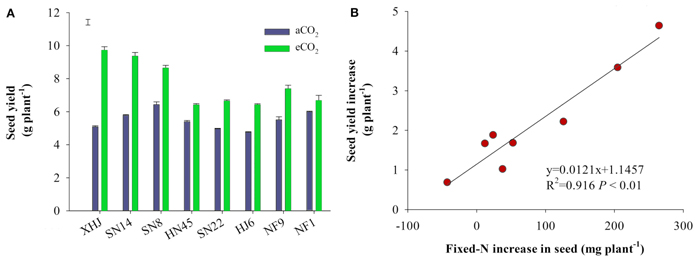| Follow @co2science |
Paper Reviewed
Li, Y., Yu, Z., Liu, X., Mathesius, U., Wang, G., Tang, C., Wu, J., Liu, J., Zhang, S. and Jin, J. 2017. Elevated CO2 increases nitrogen fixation at the reproductive phase contributing to various yield responses of soybean cultivars. Frontiers in Plant Science 8: 1546, doi: 10.3389/fpls.2017.01546.
Nitrogen (N) uptake and partitioning are key characteristics of a plant's phenotypic plasticity in responding to both biotic and abiotic changes in their growing environment. Thus, in introducing their work, Li et al. (2017) say that "investigating the cultivar variation in N uptake in response to elevated CO2 is essential to predict the adaptability of soybean cultivars and formulate the N fertilization strategy to increase N-use efficiency in the future." Therefore, it was the objective of this team of ten researchers to conduct an experiment that would do just that.
To accomplish their goal, Li et al. grew eight soybean cultivars in pots in open-top chambers under two CO2 levels (390 or 550 ppm), harvesting the plants for measurements and analysis at two growth stages (R5, the beginning of seed formation; R8, at maturity). The soil medium in the pots contained a total N content of 2.24 mg g-1 of soil and was supplied with 15N-labeled fertilizer (100 mg N kg-1), which allowed the authors to assess the impact of elevated CO2 on the sources of plant N (symbiotically-fixed N vs fertilizer-derived N vs soil-derived N) and its movement among plant organs across growth stages.
In describing their findings, Li et al. report that, averaged across all cultivars, elevated CO2 significantly increased shoot biomass by 46% (Figure 1a), total root length by 19% and seed yield by 40%. With respect to N content and source, they say that "elevated CO2 only led to small increases in the uptake of fertilizer-derived and soil-derived N during R5 to R8," which increases did not correlate with enhanced seed yield. In contrast, during the R5 to R8 stage symbiotically-fixed N "became a major contributor to [an] increased N uptake and, hence, yield gain under elevated CO2," which relationship is plotted in Figure 1b below.
Elevated CO2 was also found to decrease the proportion of remobilized N in the seed during the late reproductive phase, resulting in a lesser amount of N being removed from other vegetative organs, including leaves, which reduction likely helped to "maintain leaf photosynthetic capacity" and "contribute to the increased biomass accumulation and seed yield under elevated CO2."
The above findings reveal that soybean yields will increase in the future in response to benefits provided by rising atmospheric CO2. Furthermore, those yields will increase without the addition of soil N fertilizer, as the results of this study clearly show that it was a CO2-induced stimulation of nitrogen-fixation by symbiotic bacteria that provided the nitrogen necessary to increase seed yields.

Figure 1. Seed yield (Panel A) and the relationship between increased fixed-N in seeds and yield increment (Panel B) of eight soybean cultivars under elevated CO2 (eCO2) relative to ambient CO2 (aCO2). The eight soybean cultivars were Xiaohuangjin (XHJ, released in 1951), Hejiao 6 (HJ6, released in 1962), Nenfeng 1 (NF1, released in 1972), Nenfeng 9 (NF9, released in 1980), Suinong 8 (SN8, released in 1989), Suinong 14 (SN14, released in 1996), Heinong 45 (HN45, released in 2003), Suinong 22 (SN22, released in 2005). Adapted from Li et al. (2017).




